 Those numbers are important because they are part of the changes that make Analytical Writing (earlier called the Analytical Writing Measure) trickier and more demanding on the Revised General GRE,which was released in August last year.
Those numbers are important because they are part of the changes that make Analytical Writing (earlier called the Analytical Writing Measure) trickier and more demanding on the Revised General GRE,which was released in August last year.
So, what are the changes? Firstly as noted above, the essay section is now called just Analytical Writing (or AW for short). The ETS has been making changes in various aspects of the GRE test to make it more like the GMAT. This is one of them. The second is that the Issue Essay is now just for 30 minutes rather than 45 as earlier. This again, makes the GRE more like the GMAT.
But the ‘6’ and ‘8’ are part of a feature that is entirely unique to the Analytical Writing section of the Revised General GRE test. The numbers come in because now instead of one question type for the Issue Essay, you now have 6, and instead of one question type for the Argument Essay you now have 8. Each of the question types directs the test-taker to do or comment on something very specific relating to the given topic – and in their introductory material the ETS repeatedly states that test-takers should follow the specific directions given for the topic, so obviously it is important that you better know exactly what each question type demands and also how to meet the specific requirements.
To find out more official information about this from the ETS visit the following link:
http://www.ets.org/gre/revised_general/about/content/analytical_writing
For our perspective, wait for our upcoming blogs on the Issue and Argument Tasks. Till then, happy hunting as you check out the ETS’s requirements for the tweaked and tricky AW section!
Related Links
GRE Overview:
- Revised GRE Overview
- Challenges in the Verbal Section of the Revised GRE
- Reading Comprehension and Sentence Completion Questions: Tips
- Quantitative Reasoning Question Type Overview
- Analytical Writing Overview
GRE Practical Details:
- Registering for, Rescheduling and Cancelling Your GRE Test
- Getting Additional GRE Score Reports
- Selecting Which Scores the ETS Should Send to Universities
Some good news from US policy holders: it’s now relatively easier to get US visas! Bad news: most of you obtaining US student visa for the very first time will not be benefited from the change. This policy change will most help those in the visa ‘renewals’ category. But unfortunately a large section of F1 Visa seekers are typically applying for the very first time.
We are still reviewing the visa policy, however from the first look, it seems that not much has changed for students.
News Links:
http://www.hindustantimes.com/India-news/NewDelhi/New-US-norm-to-ease-visa-renewal/Article1-828883.aspx
http://timesofindia.indiatimes.com/articleshow/12361305.cms
Quantitative Reasoning in the Revised General GRE, like Verbal Reasoning has two sections with 20 questions each and for which 35 minutes solving time is given per section. Each Quantitative Reasoning section has mix of question types:
- quantitative comparison
- problem solving
- numeric entry questions (single and double)
- multiple correct choices (vertical check-box questions)
- single correct choice (i.e. radio button questions – vertical and horizontal)
- data interpretation
This makes a total of 7 different formats which are illustrated in the screenshots below. The screenshots are of the Dilip Oak’s Online test, but they will give you a good idea of what these formats will look like when you take the GRE computer-based test.
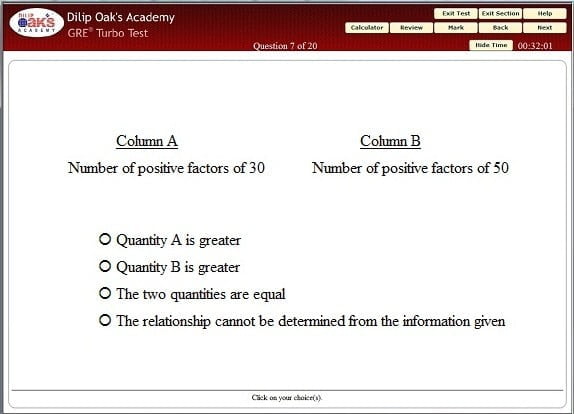
Get information on the Oak’s Online GRE test


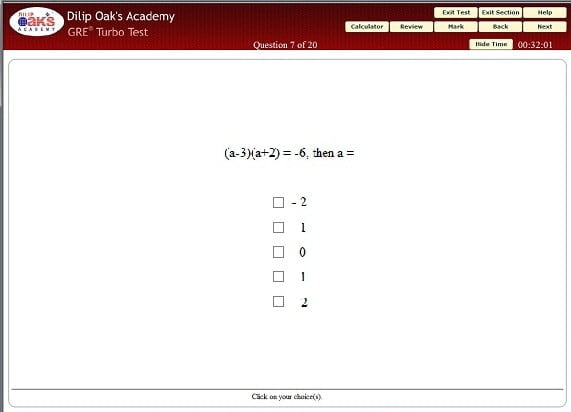
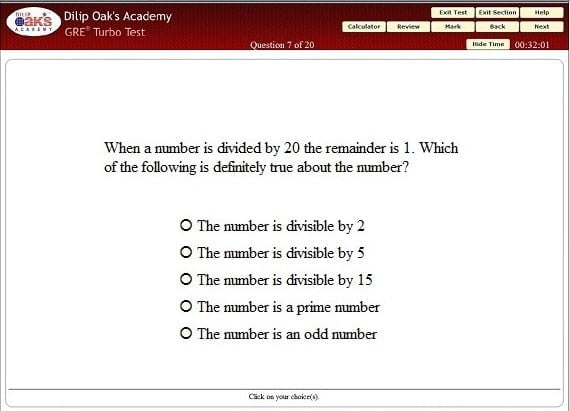

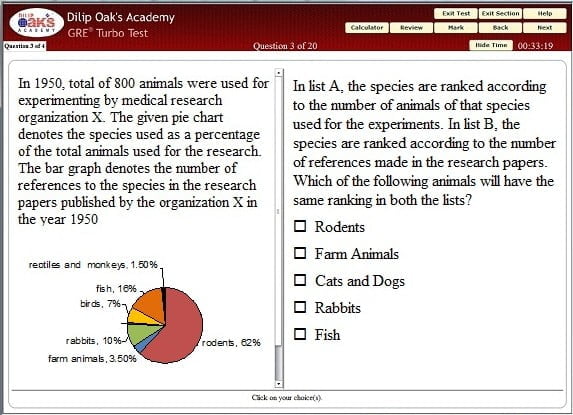
An on-screen calculator is provided to help in the arithmetic calculations. The sections check the application of the basic math formulae in real life scenarios as well as accuracy in numeric calculations.
Tips for the Handling the On-screen Calculator:
- The calculator should be used when accuracy is required for numeric entry questions; in these the answer can be directly transferred from the calculator to the numeric entry box.
- Another case where the calculator is useful is in long, difficult calculations involving decimals. If a numeric answer is to be given in terms of fractions, however, the calculator will not useful.
- Remember also, that the onscreen calculator doesn’t provide advanced scientific functions.
Don’t use the calculator for simple calculations. It is sometimes faster to calculate or approximate the answer using the given options than to use the calculator.
Related Links
GRE Overview:
- Revised GRE Overview
- Challenges in the Verbal Section of the Revised GRE
- Reading Comprehension and Sentence Completion Questions: Tips
- Analytical Writing Overview
- Analytical Writing: Why 6 & 8 Are Important Numbers in this Section
GRE Practical Details:
- Registering for, Rescheduling and Cancelling Your GRE Test
- Getting Additional GRE Score Reports
- Selecting Which Scores the ETS Should Send to Universities
So, you are preparing for the GRE test. You know that the Verbal section is going to be demanding. What are the big challenges in the Verbal section of the Revised General GRE?
Challenge #1: Reading Comprehension Passages
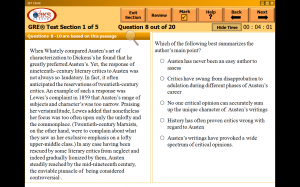
First, a bit of good bit of news: the Reading Comprehension passages on the Revised GRE test are short. A Verbal section generally contains 5 Reading Comprehension passages, most which are 20-25 lines long; and one of them may be as short as 3-5 lines. The longest passages are of about 40 lines or so. (See ETS’s introduction to reading comprehension, sample questions and tips)
But Reading Comprehension is never very easy. Firstly, the passages cover a wide variety of topics, most of which are very unfamiliar. Here are some topics that have appeared in the past:
- wave motion
- the magnetic compass sense of birds
- the contribution of a musician to the development of a certain musical genre
- volcanic hotspots in the earth’s crust
- the divergent novelistic impulses in the works of a writer are some of the topics that have previously appeared.
In other words the chances are that you will get topics in the exam which you have never come across before. The unfamiliarity of the topics, the complexity of the sentence structure and the fact that the passages pack a lot of information into very little space make the passages a challenge to comprehend.
Challenge #2: Reading Comprehension Questions
Then, there are the questions – between one and three on every reading comprehension passage. Whether the questions require you to select one option out of five or, all the correct options out of three, they all require you to make out whether the statements in the options are equivalent to the statements in the relevant part of the passage. This is difficult since the phrasing in the options and also in the passage can be quite complicated. Further, choosing between close options requires the ability to spot subtle differences between the two.
Challenge 3#: Discrete (Sentence Completion-Type) Questions
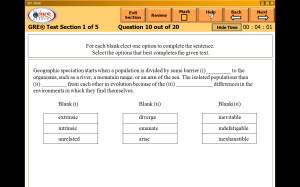
The Discrete questions are so-called since, unlike the Reading Comprehension questions, they do not come in sets on a passage. Discrete questions require the test–taker to complete one or more sentences with one or more blanks in them. One type, the Sentence Equivalence questions, requires you to complete the given sentence by selecting two synonyms out of the six options provided (see ETS’s sample sentence equivalence questions, introduction and tips). Others, called the Text Completion Questions can have up to 5 sentences and between 2-5 blanks (see ETS’s sample questions, introduction and tips)

The discrete questions require you to have a good understanding of sentence structure and of what words imply in a certain context. Since the words used in the options are often unfamiliar or are familiar words used in an unfamiliar way, discrete questions also demand that you have a good vocabulary.
Tips for Preparing for the Verbal Section
- Learn the vocabulary – knowledge of high-level vocabulary is still essential for the Discrete and Sentence Equivalence questions. Don’t believe anyone who tells you it isn’t. It is also useful for Reading Comprehension passages. So:
- Find one of the standard GRE vocabulary lists available and start learning well in advance. The lists generally contain 4,000 words and will take around 3 months to learn.
- Explore various methods of learning, because there are many methods and it might take a combination of methods to help you remember the words – and the combination of methods that works for one person may not work for another
- Revising is of utmost importance. Remember, if you don’t keep revising, you are bound to forget the words.
- Build up your exposure to areas outside the topics you normally read on – read articles from sources like the op-eds (editorials) of the New York Times (look for the ‘opinion’ heading in the top right corner). Such articles will be on a variety of topics and the kind of vocabulary and sentence structure is similar to what you have on the GRE. So, they provide excellent reading practice, especially if you keep referring to a dictionary.
- Get used to reading passages on-screen – reading on paper and on a computer screen are two entirely different things. Even if you have had a lot of practice reading on paper, reading on the screen can be quite a difficult exercise; when you are answering questions on a tough reading comprehension exercise, all the scrolling up and scrolling down can be pretty confusing. The remedy? Lot’s of practice.
Related Links
ETS’s sample questions of all three types
GRE Overview:
- Revised GRE Overview
- Challenges in the Verbal Section of the Revised GRE
- Quantitative Reasoning Question Type Overview
- Analytical Writing Overview
- Analytical Writing: Why 6 & 8 Are Important Numbers in this Section
GRE Practical Details:
- Registering for, Rescheduling and Cancelling Your GRE Test
- Getting Additional GRE Score Reports
- Selecting Which Scores the ETS Should Send to Universities
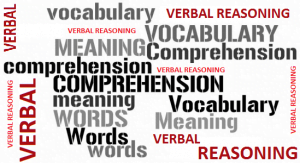 When the Revised General GRE test was launched (way back on 1 August 2011), a whole host of changes was introduced. One consequence was a revamped Verbal Reasoning part in which there are now:
When the Revised General GRE test was launched (way back on 1 August 2011), a whole host of changes was introduced. One consequence was a revamped Verbal Reasoning part in which there are now:
- two Verbal sections in the test with a total of 40 questions, instead of one section with a total of 30 questions
- no Antonyms and Analogy questions – these have been replaced by more Reading Comprehension passages.
- Text Completion questions (which require you to fill up to 3 blanks in a passage which can contain up to five sentences) and
- Sentence Equivalence questions (which require you to select two correct synonyms to fill in the blank in the sentence out of the 6 options given)
- Sentence Completion questions with single- and double-blanks
.
To sum up, Reading Comprehension is now more important, the Sentence Completion type questions got a little harder to get right and Vocabulary is more or less just as important as it was earlier – so, you still have to learn that GRE word list!). As a result of those two changes, students also find the Verbal section harder to complete on time. So, how do you handle that difficulty?
Tips for Handling the Verbal Section
- Get plenty of practice with computer-based tests: no matter how much practice you have done on paper, a whole computer-based test is a very different thing – and take at least a few tests along with the essay (Analytical Writing) section.The Analytical Writing section puts a heavy drain on your time, energy and concentration, and you should not encounter that for the first time in your actual GRE test!
- Focus on the easier questions first – don’t get stuck on the difficult ones and waste time on them in the beginning. Start by quickly answering the questions that you find easiest.
- On the other hand, don’t leave questions unanswered – you may not have time to come back to unanswered questions in the Verbal section So, even if you are not very sure about the answer to a question, mark in your best guess and if there is time come back to it.
But, beyond that what are the specific challenges involved in the Verbal section of the Revised General GRE and more important how do we gear up to meet them? Read more on our next posts on the difficulties in the Reading Comprehension and Sentence Completion, and how to get an edge in cracking them?
Related Links
GRE Overview:
- Revised GRE Overview
- Reading Comprehension and Sentence Completion Questions: Tips
- Quantitative Reasoning Question Type Overview
- Analytical Writing Overview
- Analytical Writing: Why 6 & 8 Are Important Numbers in this Section
GRE Practical Details:
- Registering for, Rescheduling and Cancelling Your GRE Test
- Getting Additional GRE Score Reports
- Selecting Which Scores the ETS Should Send to Universities


